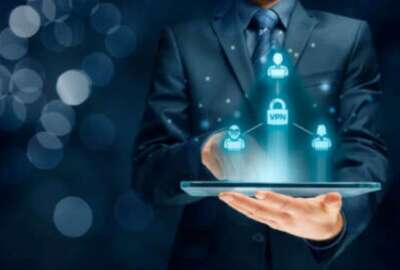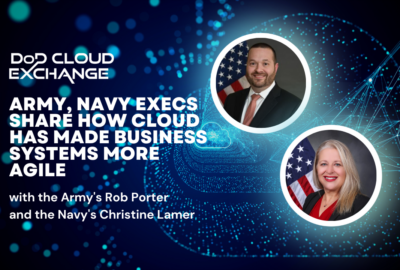DoD Cloud Exchange 2024: Navy’s Louis Koplin on service’s digital transformation horizon
Using four-phase "horizon" process, Navy balances user experience and security to bring innovative services to the enterprise.
The Navy bases its guiding principles for digital transformation on four basic concepts that is calls “horizons.”
Its Naval Identity Services are on the cusp of Horizon 1 — being offered as an enterprise service.
Meanwhile, the service’s virtual desktop pilot aims to make it easier for sailors, seamen, civilians and contractors to bring their own devices onto Navy networks. The service expects the pilot to remain in Horizon 2 for the foreseeable future, said Louis Koplin, executive director of the Navy’s Program Executive Office for Digital and Enterprise Services. The pilot’s team must demonstrate that the approach is ready to move into an enterprisewide service.
There are a host of other digital services that are in Horizon 3, the evaluation stage of whether it even makes sense to test them for enterprise use. And Horizon 0 is when a service or system is set to be retired.
Koplin said moving a project into Horizon 2 depends on several considerations.
The first is obvious: Does something actually need to be an enterprise service?
“If you build something that is lean learning and enabling so it’s efficient, it’s lightweight and it’s responsive to feedback and gets better, and actually lets people do their jobs faster, quicker, more securely and more cheaply, no one’s not going to want to use it. So you build a world-class product, and people are going to adopt it,” Koplin said on Federal News Network’s DoD Cloud Exchange 2024.
“On the flip side, there’s definitely value in the designation — for one thing, the process statements and criteria that really forces things to get to a certain level of maturity. We don’t want to put out something that is not credible. I personally have been very defensive about what we call an enterprise service for that reason. I don’t want to put something out that we announced as an enterprise service mandatory use, and then people go and they literally can’t order it. There’s no website. There’s no rate card, or maybe it’s centrally funded, or maybe it’s not. Maybe it’s on less than a full authority to operate. We’ve seen these attempts in the past, and it really is corrosive to the mindsets we want to have with digital experimentation and scaling, and innovation adoption.”
Finalizing memo on Navy Identity Services
The second useful part about the designation as an enterprise service is that it becomes a part of the Navy’s enterprise architecture. Navy PEO Digital detailed each of the technology horizons as part of a communication to industry.
Take the Naval Identity Services. The Navy has been testing NIS out for several years. It’s a key piece of the service’s zero trust journey and consolidates and standardizes the Navy around identity and access management.
The success of the NIS means Navy leadership is expected to sign a memo designating it as an enterprise service this spring.
“It’s got a bunch of things that are really great. The one that I think people don’t realize that I like the best is it allows us to do away with a system access authorization request, that DD-2875 form. It’s not because we’re not doing those checks and balances, of course, but because there’s a workflow and integration with authoritative data sources,” he explained. “For instance, being able to pull civilian status data from the Defense Civilian Personnel Data System instead of having someone type it in, or from the Defense Manpower Data Center for the official defense manpower data. I mean, that’s just great. It saves time, saves effort and the data quality is higher. Then, knowing that you’ve got access to an enterprise information environment when you onboarded, now we don’t need to fill out more of those PDFs. All we have to do is update the attributes, which roles and which workloads are you going to get access to. We have an automated standardized way to do that.”
Koplin said the benefits of NIS will extend beyond individuals, and help the Navy in other ways, including with the goal of being financially auditable, federating privileged access management and giving users the ability to work offline, afloat and disconnected.
“Coming up in the next few months, we’ll start work on the Impact Level 6 implementation to go to the secret level,” he said. “We’re working on integration with Marine Corps directory services, synchronization with the Flank Speed attributes. In some cases, we are retiring some legacy identity infrastructure. But in other cases, it’s integrating where it’s already modernized and underpinning our zero trust cloud, and it brings additional capabilities in terms of automation, integration and control.”
Making progress on Navy-wide virtual desktop
The Navy’s other digital transformation efforts are a bit behind NIS.
The service is piloting a virtual desktop for bring your own device users with about 1,000 people. Known as Nautilus, the program aims to take these efforts across the virtual desktop, the physical endpoint and to mobile devices.
“We’re scaling all of them in line roughly with the Windows 11 mandate timeline, so that puts us around 18 months from now. The goal is to have all these composed capabilities that can meet different mission needs based on the persona of the customer that we’re supporting,” Koplin said. “There are some personas that the virtual desktop is great for them because either they don’t get issued a government device or they do today, but we’d like not to issue them a government device. The Naval Reserves have been big users of Nautilus’ virtual desktop.”
Another ideal Nautilus persona is an employee from industry who needs access to the Navy’s networks but can’t have a government-furnished device.
For most Navy servicemembers and civilians, however, the benefits of Nautilus will be two-fold.
“What this really lets us do is reset and go back to industry standard commercial configurations and commercial business processes so that you can log into a device fresh out of the box off the shelf. Just by using your Flank Speed email, your government email, it will log in, connect to the server, configure and register the asset, do all those things. So within, say, 30 minutes, you’re up and running,” Koplin said. “When we talk about moving the dial on those world-class alignment metrics in terms of having a higher customer satisfaction experience and reducing the time from potentially weeks or days to hours or minutes, it knocks them out of the park on many fronts. And that device is fully well managed in our zero trust architecture.”
Accelerating Navy cloud capabilities
Underpinning many of these efforts is the Navy’s cloud management office runs called Neptune. PEO Digital recently went live with the first incremental upgrade of a servicewide cloud portal, and now it’s going to accelerate the pace to deliver more capabilities, Koplin said.
“2024 is definitely a building year for us, and that’s where we focus our efforts on getting applications migrated and modernized. But absolutely, we need to think about how we do that and that we’re not pushing a rope; that we don’t want to lift and shift an archaic application into a modern cloud environment and not really gain benefits — potentially even incur greater costs — because it’s not really a cloud-compatible architecture,” he said. “We are being very deliberate about how we do that. There are a lot of things in flight now that I expect to see bear fruit over the rest of 2024 into 2025, whether it’s those standardized onboarding processes, cloud maturity frameworks, standardizing some of our service models and service level objectives and agreements, our financial operations capability. It’s really keeping an eye on the business command and control of our cloud environments and how we’re consuming cloud.”
Koplin said the Navy isn’t doing all of these technology initiatives in a vacuum. The end goal isn’t just to implement the technology but rather improve the end user’s experience without sacrificing cybersecurity.
“Typically, we see this trade-off between security and convenience, customer experience versus cybersecurity. But in the case of zero trust, we’re getting more of both. That’s really exciting when you can make the users happier with a more convenient, lower-friction experience and the cyber operators happier because they have greater control, greater visibility and more fine-grained control,” he said. “We are really helping to enable that change in terms of designing, delivering and sustaining this world-class digital experience. One of the ways we do that is with our world-class alignment metrics, things like reducing user time lost, improving customer satisfaction and improving our adaptability and mobility.”
Discover more articles and videos now on Federal News Network’s DoD Cloud Exchange event page.
Copyright © 2025 Federal News Network. All rights reserved. This website is not intended for users located within the European Economic Area.
Jason Miller is executive editor of Federal News Network and directs news coverage on the people, policy and programs of the federal government.
Follow @jmillerWFED







